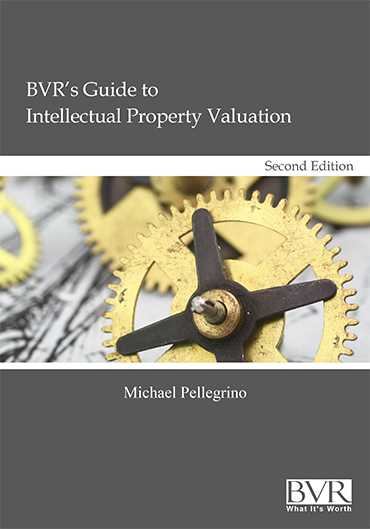BVR's Guide to Intellectual Property Valuation, Second Edition
March 2012 ISBN#: 978-1-935081-60-9 Hardcover, PDF (367 pages)
Michael Pellegrino
Business Valuation Resources, LLC
Author and leading IP expert Michael Pellegrino analyzes real-world examples of IP valuation and discusses each of the primary IP categories including patents, trademarks, copyrights and trade secrets. This edition includes chapters on:
- Valuation approaches and guidance
- Due diligence
- Discount rate development
- Royalty rates
- And much more
This publication and many more are also available for download with a subscription to the Digital Library or BVResearch Pro.
Add to cart
This is an approximate price based on the current exchange rate of {rate}. All purchases will be settled in USD.
Table of Contents
- CHAPTER 1: ABOUT THIS GUIDE
- The Growing Importance of IP
- Why Is This Guide Needed?
- What This Guide Is Not
- CHAPTER 2: IP VALUATION OVERVIEW
- About Patents
- The Advantages of Patents
- The Disadvantages of Patents
- About Copyrights
- The Advantages of Copyrights
- The Disadvantages of Copyrights
- About Trademarks
- The Advantages of Trademarks
- The Disadvantages of Trademarks
- About Trade Secrets
- The Advantages of Trade Secrets
- The Disadvantages of Trade Secrets
- CHAPTER 3: ABOUT IP VALUATION
- Applying the Science
- Practicing the Art
- The Science-Art Continuum
- CHAPTER 4: USING VALUATION APPROACHES
- The Cost Approach
- The Market Approach
- The Income Approach
- The Assignment-Approach Match
- Common Pitfalls of the Various Approaches
- Reconciling Several Valuation Approaches
- Valuation Method Selection Summary
- CHAPTER 5: GENERAL DUE DILIGENCE
- Performing Initial Interviews
- Analyzing Historical Financials
- Understanding the IP
- Verifying IP Ownership
- Commissioning Independent Counsel Review
- Reviewing Enforcement History and Ability
- Performing Market Analysis
- Evaluating the Regulatory Environment
- CHAPTER 6: PATENT DUE DILIGENCE
- The Invention Status
- Current Art
- Patent Utility
- Patent Quality
- Patent Age
- The Administrative House
- Blocking Patents
- Status of Active Administrative or Legal Actions
- Outstanding Contractual Provisions Affecting Value
- CHAPTER 7: COPYRIGHT DUE DILIGENCE
- Nature of the Copyrighted Material
- Verifying the Nature of Rights to Value
- Administrative Issues That Can Impair Copyright Value
- Registration
- Factual Works
- Fair Use Value Erosion
- Work Made for Hire
- Copyright Notice
- Ease of Duplication
- Mechanical Rights for Nondramatic Musical Works
- Termination of Transfers
- Public Domain
- Visual Artists Rights Act of 1990
- Special Considerations for Computer Software
- Easier to Avoid Infringing Activity
- Disclosure
- The Rule of Doubt
- Special Considerations for Semiconductor Designs or Masks
- CHAPTER 8: TRADEMARK DUE DILIGENCE
- What Is Trademark Due Diligence?
- Maintenance Fees
- Owner of Record
- Pending Trademark Challenges
- Continued Use
- Public Notice
- Durability
- Incontestability
- Interference
- Standards of Use
- Trademark Strength
- Dilution
- Counterfeit Risk
- Market Dynamism
- Fair Use Value Impacts
- CHAPTER 9: TRADE SECRET DUE DILIGENCE
- Trade Secret Value Sources
- Trade Secret Floor Value
- Factors That Prolong Trade Secret Value
- Factors That Kill Trade Secrets
- Litigation Effects
- Inadvertent Disclosures
- Trade Secret Agreement Terms
- Publication as Patent or Copyright
- CHAPTER 10: DISCOUNT RATE DEVELOPMENT
- Accounting for IP Risk
- Deeper Analysis of Current Methods
- An IP Discount Rate Estimation Model
- Target Rate of Return
- Holding Period
- Success Rates
- Target Returns
- Investment Expenses
- What About Empirical Evidence of Support?
- Proving the Model
- Model Extensions
- Back to the Roots
- Real-World Examples
- CHAPTER 11: DETERMINING ROYALTY RATES
- Royalty Rate Considerations
- Royalty Rate Magnitude
- Common Royalty Rate Determination Methods
- Analytical Royalty Rate Determination Process
- Calculating the Value Proposition
- Determining Licensor and Licensee Contributions
- Analytical Method Attack Points
- CHAPTER 12: CASE STUDY IN IP VALUATION
- A Poor Example of Celebrity Valuation
- A Credible Approach to Celebrity Valuation
- CHAPTER 13: MANAGING AN ENGAGEMENT
- Project Preparation
- Initial Due Diligence
- IP Analysis
- Market Analysis
- Valuation Modeling
- Valuation Reporting
- Project Support
- CHAPTER 14: AUDITOR’S REVIEW GUIDE
- Analyzing the Analyst
- Analyzing the Due Diligence
- Report Boilerplate
- Economic Conditions and Nature of the Industry
- IP Utility
- Government Protections
- Functional Realization
- Demand Analysis
- Financial History
- Chronology
- Royalty Rate Analysis
- Income Approach Using Reasonable Royalty Method
- Consideration of Cost Approach
- Use of Market Methods for IP Valuation
- Use of Valid and Reliable Inferential Statistics
- Repeatability
